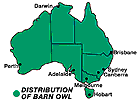Burke’s Backyard visited Sydney’s Taronga Zoo, which has a clinic for the treatment of injured native wildlife. John Dengate talked to rehabilitation officer, Libby Hall, about a barn owl. After being hit by a car, the bird was receiving some tender, loving care at the zoo. It has healed well and soon will be banded for future identification and released back to its urban habitat.
Barn owl (Tyto alba)
Barn owls are nocturnal predatory birds with flat, heart-shaped faces, large, dark eyes, small beaks and large talons. They are pale in colour, and have grey and buff upperparts with black and white spots, and white underparts with scattered black spots. Their diet consists mainly of rats and mice, as well as small birds. Barn owls roost during the day in tree or rock hollows, then come out to hunt about one hour after sunset. They are found in all parts of Australia.
Barn owls rely on their specialised hearing to hunt in the dark. They use their facial disks to take in sounds from all directions, then process the sound through their ears. The ears are asymmetrical – one is on the forehead area and the other level with the nostril. Primary wing feathers at the front of the wing help the barn owl to fly silently, and approach its prey virtually undetected.
Owl claws
Threats to urban owls
City-dwelling owls such as the barn owl often fly into the windows of buildings. They are also hit by cars. If owls eat rats or mice that have been baited with rat baits, they get secondary poisoning. Many owls live in the hollows of large trees. When trees are cut down or when land is subdivided and cleared, the owls lose their homes.
What to do
Plant a native garden and leave your large trees in place. Instead of poisoning rats and mice leave them for owls to eat, or use traps. If you find an injured owl contact your local zoo, wildlife rescue service or vet for advice. Birds of prey have very sharp beaks and powerful talons, so it is best to throw a towel or cloth over the bird prior to handling. Injured animals and birds should be kept in a box in a quiet, dark, warm spot to reduce the effects of shock. Do not try to feed them or give them water and handle them as little as possible. Get them veterinary attention as quickly as possible.
Further information
Our segment was filmed at
Taronga Zoo, Sydney
Phone: (02) 9969 2777
Email: [email protected]
Website: http://www.zoo.nsw.gov.au/



